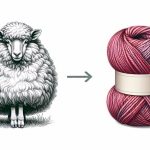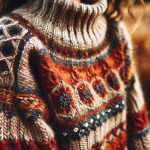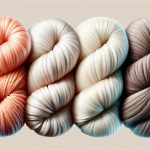When it comes to fabrics, you might wonder if any can naturally resist stains, odors, and wrinkles. While some materials like wool show impressive qualities in these areas, others require treatments to enhance their performance. Understanding the nuances between natural and synthetic options can greatly influence your choices. So, what are the best fabrics to evaluate for your wardrobe or home textiles? Let’s explore the possibilities.
Table of Contents
Key Takeaways
- Wool is naturally stain and odor resistant, offering some level of wrinkle resistance due to its unique fiber structure.
- Cotton and linen provide moderate odor resistance but are less effective against stains and wrinkles compared to treated fabrics.
- Silk has low odor resistance and is prone to staining, making it less ideal for those seeking all three natural properties.
- No single natural fabric excels in all three categories; often, treated fabrics combine benefits of stain, odor, and wrinkle resistance.
- For optimal performance, consider blends or treated fabrics that enhance natural qualities for stain, odor, and wrinkle resistance.
Understanding Natural Stain Resistance in Fabrics
When you choose fabrics, understanding their natural stain resistance can make a big difference in your daily life. Some materials, like cotton and linen, tend to absorb liquids quickly, leading to stubborn stains.
However, fabrics like wool and silk have inherent properties that repel certain substances, making them less prone to staining.
It’s important to contemplate the fabric’s weave and finish, as these factors also influence stain resistance. For example, tightly woven fabrics can help prevent spills from soaking in.
Additionally, some treatments enhance a fabric’s stain resistance without compromising its natural qualities. By selecting the right materials, you can reduce the hassle of cleaning and enjoy a more effortless lifestyle.
Prioritize fabrics that suit your needs and lifestyle for maximum convenience.
Exploring Odor Resistance in Natural Materials
Natural fabrics not only offer stain resistance but also possess properties that combat odors. You’ll find that materials like wool, cotton, and hemp have unique characteristics that help minimize unpleasant smells. These fabrics can wick moisture away, preventing the growth of odor-causing bacteria.
Here’s a quick comparison of some natural materials and their odor-resistant properties:
| Material | Odor Resistance |
|---|---|
| Wool | High |
| Cotton | Moderate |
| Hemp | High |
| Linen | Moderate |
| Silk | Low |
Choosing the right fabric can enhance your comfort and freshness throughout the day. So, when picking your next outfit or home textiles, consider these odor-resistant options to stay smelling great!
The Role of Wrinkle Resistance in Fabric Selection
Wrinkle resistance is an essential factor to take into account when selecting fabrics for your wardrobe or home. You want materials that maintain their appearance throughout the day, especially if you lead a busy lifestyle.
Fabrics that resist wrinkling save you time on ironing and let you focus on what matters most. When choosing clothing, consider how often you’ll wear it and the occasions it suits.
For home textiles, think about how wrinkle resistance can enhance the overall look of your space. Fabrics like cotton blends or certain natural fibers can offer this quality while remaining comfortable and stylish.
Overview of Synthetic Fabrics and Their Properties
Although many people appreciate the softness and breathability of natural fibers, synthetic fabrics offer a range of properties that can make them ideal for various applications.
These fabrics, like polyester, nylon, and spandex, are engineered for durability, often resisting wear and tear better than their natural counterparts. You’ll find that synthetic materials are typically moisture-wicking, helping to keep you dry during physical activities.
Additionally, they’re often stain-resistant, making them easier to maintain. Their lightweight nature and quick-drying capabilities also make them popular for travel and outdoor gear.
While they may lack some natural qualities, the versatility of synthetic fabrics guarantees that you have options to suit your lifestyle, whether for everyday wear or specialized uses.
Combining Natural and Synthetic Elements for Enhanced Resistance
By blending natural and synthetic fibers, manufacturers create fabrics that offer both comfort and enhanced resistance to stains, odors, and wrinkles.
This combination leverages the breathability and softness of natural fibers like cotton or linen, while incorporating the durability and resilience of synthetic options such as polyester or nylon.
You get the best of both worlds—fabrics that feel great against your skin and stand up to daily wear and tear.
These hybrid materials not only enhance your wardrobe but also reduce the frequency of washing, helping to maintain fabric integrity longer.
The Benefits of Treated Fabrics for Multi-Resistance
When you choose treated fabrics, you’re tapping into enhanced performance features that make your life easier.
These fabrics resist stains, odors, and wrinkles, giving you confidence in various settings, from casual outings to formal occasions.
Plus, their versatility opens up a world of application opportunities, ensuring you always look your best.
Enhanced Performance Features
As you seek out fabrics that stand the test of time, enhanced performance features in treated materials can truly make a difference.
These fabrics are engineered to resist stains, odors, and wrinkles, saving you time and effort on upkeep. Imagine wearing clothes that look fresh and clean all day, even after multiple uses.
Treated fabrics repel spills and minimize odors, allowing you to feel confident and comfortable. Plus, their wrinkle-resistant properties mean you can say goodbye to ironing.
Whether you’re dressing for work or leisure, these advanced textiles help you maintain a polished appearance effortlessly.
Investing in enhanced performance fabrics not only elevates your wardrobe but also simplifies your life, giving you more time to focus on what really matters.
Versatile Application Opportunities
Treated fabrics offer a world of versatile application opportunities, making them ideal for various settings and lifestyles. You’ll find these fabrics perfect for activewear, home furnishings, and travel gear. Their ability to resist stains, odors, and wrinkles means you can enjoy convenience without sacrificing style. Picture your favorite white shirt staying crisp and fresh all day or your couch repelling spills effortlessly.
Here’s a quick look at where treated fabrics shine:
| Application | Benefits | Ideal Uses |
|---|---|---|
| Activewear | Moisture-wicking, odor-free | Gym, sports events |
| Home Furnishings | Easy cleaning, wrinkle-free | Sofas, curtains |
| Travel Gear | Durable, stain-resistant | Luggage, travel clothes |
Practical Applications of Stain, Odor, and Wrinkle Resistant Fabrics
When choosing fabrics for upholstery, outdoor furniture, or professional workwear, stain, odor, and wrinkle resistance can make a huge difference.
You’ll appreciate how these features enhance durability and ease of maintenance in your daily life.
Let’s explore some practical applications that highlight the benefits of these advanced fabrics.
Upholstery Fabric Choices
Choosing the right upholstery fabric can make all the difference in maintaining a fresh and inviting living space. Opting for naturally stain, odor, and wrinkle resistant fabrics means less time worrying about upkeep and more time enjoying your home. Here’s a quick comparison of popular upholstery options:
| Fabric Type | Stain Resistance | Odor Resistance |
|---|---|---|
| Microfiber | High | Moderate |
| Cotton Blend | Moderate | Moderate |
| Performance Fabric | High | High |
| Velvet | Low | Low |
When you select the right fabric, you can enhance your furniture’s durability while keeping your space looking immaculate. Consider your lifestyle and choose wisely for lasting beauty and ease.
Outdoor Furniture Applications
Selecting the right upholstery fabric not only enhances your indoor space but also sets the stage for your outdoor furniture.
Choosing fabrics that are naturally stain, odor, and wrinkle resistant means you can enjoy your outdoor setup without constant worry. Imagine hosting a barbecue with friends, where spills are inevitable. With the right fabric, you won’t have to stress about red wine stains or greasy fingerprints.
Plus, these fabrics resist fading from sun exposure, keeping your furniture looking vibrant. When unexpected rain hits, wrinkle resistance guarantees your cushions stay crisp and ready for use.
Investing in high-quality outdoor fabrics transforms your patio into a stylish, low-maintenance oasis, allowing you to focus on relaxation and enjoyment.
Professional Workwear Solutions
How can you guarantee your professional workwear stands out while remaining practical? By choosing fabrics that are naturally stain, odor, and wrinkle resistant, you’ll enhance your appearance and assure comfort throughout your workday.
Imagine wearing uniforms that repel spills, maintain freshness, and look sharp without constant ironing. This means less time worrying about your outfit and more time focusing on your tasks.
Industries like healthcare, hospitality, and construction benefit greatly from these fabrics. They not only promote a professional image but also boost employee confidence and morale.
Investing in high-quality, functional workwear allows you to showcase your brand while providing durability and ease. With these solutions, you’ll create a polished look that meets the demands of your busy work environment.
Evaluating the Performance of Specialty Fabrics
What factors should you consider when evaluating the performance of specialty fabrics?
Start by examining the fabric’s durability and how well it withstands wear and tear.
Next, look into its resistance to stains, odors, and wrinkles.
Assessing a fabric’s resistance to stains, odors, and wrinkles is essential for maintaining its appearance and longevity.
You’ll also want to check the breathability and moisture-wicking properties, which can enhance comfort.
Additionally, consider the fabric’s environmental impact and whether it’s sustainably produced.
Finally, evaluate the maintenance requirements, as some specialty fabrics may need specific care to retain their benefits.
- Durability against wear and tear
- Stain, odor, and wrinkle resistance
- Breathability and moisture-wicking
- Environmental sustainability
- Maintenance and care requirements
Future Trends in Fabric Technology and Resistance Features
As technology continues to evolve, the future of fabric innovation promises exciting advancements in resistance features that cater to consumer needs.
You’ll likely see fabrics that not only repel stains and odors but also offer enhanced durability and comfort. Researchers are exploring bioengineered fibers that harness natural properties, making them more sustainable while still delivering superior performance.
Imagine clothing that adjusts its temperature based on your body heat, or textiles that self-clean with just a splash of water. Smart fabrics integrating sensors will also track your activity, providing real-time feedback.
By incorporating these cutting-edge technologies, the fabrics of tomorrow will redefine convenience, ensuring you stay fresh and stylish without the usual upkeep.
Embrace these advancements; they’re the future of fashion.
Frequently Asked Questions
What Are the Best Natural Fabrics for Stain Resistance?
When considering natural fabrics for stain resistance, cotton and linen are your best bets. They’re breathable, easy to clean, and hold up well against everyday spills, making them practical choices for your wardrobe.
How Can I Enhance Fabric Resistance at Home?
If you’ve spilled coffee on your favorite shirt, you can enhance fabric resistance at home by applying a fabric protector spray. Just make certain it’s suitable for your fabric type, and follow the application instructions carefully.
Are There Eco-Friendly Options for Multi-Resistant Fabrics?
You can explore eco-friendly options like organic cotton, hemp, or bamboo, which offer natural resistance to stains and odors. These materials are sustainable and often treated with minimal chemicals, enhancing their durability and performance.
How Do Fabric Blends Affect Resistance Properties?
Fabric blends greatly impact resistance properties. When you combine different fibers, you enhance durability, moisture-wicking, and stain resistance. Experimenting with various blends helps you find the ideal balance for your specific needs and preferences.
Which Treatments Are Most Effective for Odor Resistance?
To enhance odor resistance, you can choose treatments like antimicrobial finishes, activated charcoal infusions, or moisture-wicking technologies. These methods effectively combat odors, keeping your fabrics fresher, cleaner, and more pleasant for daily wear.
- Is a Philippine Peso Bill Made From Abaca Fiber? the Facts Revealed - June 25, 2025
- Abaca Fiber Products: 10 Sustainable Swaps for Your Home - June 25, 2025
- Weaving With Abaca Fiber: a Beginner’s Guide to a Traditional Craft - June 25, 2025






